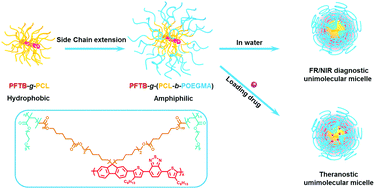Theranostic unimolecular micelles of highly fluorescent conjugated polymer bottlebrushes for far red/near infrared bioimaging and efficient anticancer drug delivery†
Abstract
We report the molecular design, synthesis and characterization of multifunctional unimolecular micelles formed by amphiphilic bottlebrush-like grafted block copolymers with theranostic functions of bright far red/near infrared (FR/NIR) fluorescence and anticancer drug delivery. Specifically, conjugated polymer poly(fluorene-alt-(4,7-bis(hexylthien)-2,1,3-benzothiadiazole)) (PFTB) was utilized as a fluorescent backbone and a macroinitiator for grafting with polycaprolactone (PCL) and poly[oligo(ethylene glycol) methyl ether methacrylate] (POEGMA) blocks via ring opening polymerization (ROP) and atom transfer radical polymerization (ATRP) successively, resulting in highly fluorescent polymer bottlebrushes, PFTB-g-(PCL-b-POEGMA). The amphiphilic and branched nature of these grafted block copolymers enabled the formation of unimolecular micelles (UMs) that were well dispersible in aqueous media. A series of PFTB-g-(PCL-b-POEGMA) polymers with the same conjugated backbone but different lengths of PCL and POEGMA side chains form UMs with different sizes and morphologies. A morphological transition of UMs from a spherical to a flower-like structure was observed with the increase of the POEGMA chain length. Compared to polymer PFTB-g-POEGMA, the introduction of hydrophobic and biodegradable PCL segments improved the fluorescence quantum yield from 0.16 to 0.25, accompanied by an obvious enhancement of the photostability of the UMs. These optical properties and the good biocompatibility of these UMs make them attractive as bioimaging probes for the visualization of biological systems. Moreover, the hydrophobic PCL domains in these fluorescent UMs provide a reservoir for loading hydrophobic anticancer drugs such as doxorubicin (DOX). The effect of PCL and POEGMA chain lengths on the drug loading and release was studied. These DOX-loaded UMs could be taken up well by HeLa and L929 cells and showed selectively higher cytotoxicity against HeLa cells than L929 cells, thereby representing a promising candidate for cancer theranostics.


 Please wait while we load your content...
Please wait while we load your content...